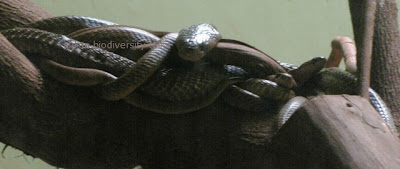Short URL for the Story: http://goo.gl/7yMSp
The study conducted by famous herpetologist
Romulus Whittaker and his son and conservation biologist Samir Whittaker points
out that the antivenom production in India is based on the venom of the snakes
present in the southern part of the country which makes it less effective in
the treatment of snakebites in other parts of the country.
The difference in the venom composition
among the sub species among the four most venomous snakes is also causing the
issue. The study shows that there are at least four cobras, eight different species
of Kraits, two sub species of Saw-scaled vipers and a single species of Russell
’s viper in the country, as per most latest taxonomical data. Further studies should be carried out to understand
the difference in the venom composition between these species and the effectiveness
of presently producing antivenom against these different species, it says.
What happens if a King Cobra (Ophiophagus hannah) bites you during a trek through an Indian forest? You are left to die even if you reach a hospital within minutes, since there is virtually no antivenom produced in India for wide distribution to treat King cobra bites, shows a new study. Leave alone King cobra, which is a rare sight reserved for lucky ones, a usual Indian cobra bite from a North Indian city can also finish you off for similar reasons.
Antivenom production and snake bite
treatment in a country which is home to several species of fatally poisonous
snakes and an upper estimated annual snake bite deaths of 50000, are in a pathetic
state, indicates a research article published in the latest issue of current
Science journal.
 |
| Indian Cobra (Naja naja) Image: Indian Biodiversity Talks |
Venom supply, rate and quality of
antivenom production, antivenom potency are way too low than the requirements. According
to the article, a major part of the snake venom is sourced from Irula Snake Catchers
Industrial Cooperative Society in Chennai which is the largest legally
acknowledged entity providing venom for the seven antivenom producing pharmaceutical
companies in the country. It causes two issues – scarcity in venom supply and
ineffective venom samples for antivenom production for snake bite treatment in other regions.
Geographical
difference in snake venom composition
In India, there are four major snakes which–
Indian Cobra (Naja naja), Common
Krait (Bungarus caeruleus), Russell's viper (Daboia russelii) and Indian saw-scaled viper (Echis carinatus) – known as the big four -which can deliver fatal bites.
However, the strength of venom differs even
within the same species in different parts of the country. According to the
study, Russel’s Viper found in northern and western parts of the country are
twice as venomous as their southern counter parts. The case is same with Indian
Cobra. Cobras from eastern parts of India are more venomous than those from
other parts. It makes the antivenom made by venom samples from South India less
effective in other parts, often causing death of the victim.
 |
| Indian Cobra (Naja naja) found in South India Image: Indian Biodiversity Talks |
Other
venomous snakes in India
The study also indicates that there could
be a need to produce antivenom for at least some other snake species found in
India since they also found to be capable of injecting lethal amounts of venom.
Since there are rare reported instances of death from bites of sea snakes and King
Cobra, presently there is no antivenom produced in India to treat any such
situation. “The average venom yields
indicate that, although antivenom is not made specifically for these species or
variants, all of them can inject potentially lethal quantities of venom”, says
the study.
Need
of the hour
The changing potency of antivenom produced
in India is also an aspect which needs urgent attention. According to the study,
the potency of cobra antivenom was 0.60 mg/ml before 1950s which has now turned
into just 0.60 mg/ml while that of Russell’s Vipers was 2 mg/ml earlier and
0.45 mg/ml now. The standards of antivenom potency and quality of antivenom production
in the country should be refined based on further studies, points out the researchers.
The study calls for urgent need to make sufficient
units to produce venom for producing enough quantities of antivenom in India,
by making snake catchers’ societies in line with the Irula society. This will
help meet the treatment needs of bites from regionally present species more
effectively and will curb clandestine venom producing operations that take
place in the country now, says the study.
Read More: How to avoid snakebites
Read More: How to avoid snakebites

No comments:
Post a Comment
Please feel free to have your say on our stories. Comments will be moderated. anonymous Comments will not be approved. No links in the comment body unless meant for sharing a very relevant info.